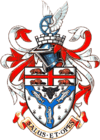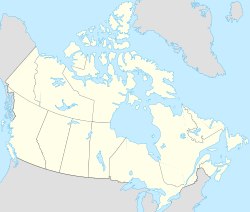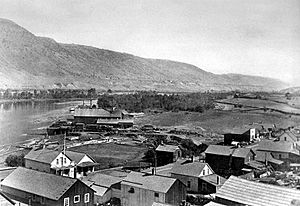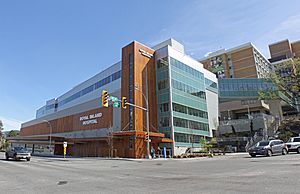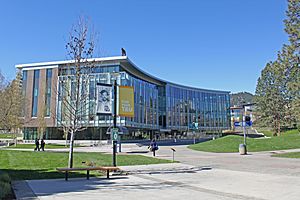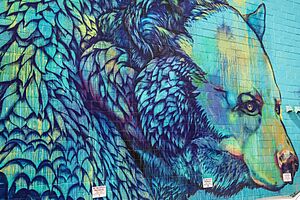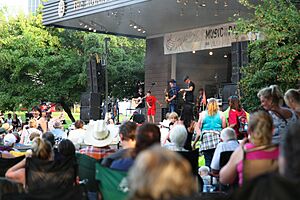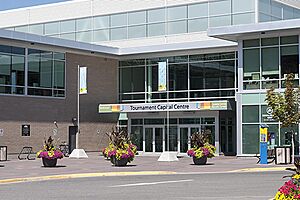Kamloops facts for kids
Quick facts for kids
Kamloops
Tk'əmlúps
|
|||||
|---|---|---|---|---|---|
|
City
|
|||||
| City of Kamloops | |||||
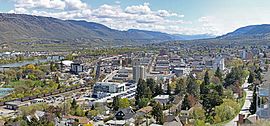
Downtown Kamloops
|
|||||
|
|||||
| Motto(s):
Salus et Opes (Health and Wealth)
|
|||||
| Country | Canada | ||||
| Province | British Columbia | ||||
| Region | Thompson Country | ||||
| Regional district | Thompson–Nicola | ||||
| Founded | 1811 (fur trading post) | ||||
| Incorporated | 1893 | ||||
| Amalgamated | 1973 | ||||
| Government | |||||
| • Type | Elected city council | ||||
| Area | |||||
| • Land | 299.25 km2 (115.54 sq mi) | ||||
| Elevation | 345 m (1,132 ft) | ||||
| Population
(2021)
|
|||||
| • City | 97,902 | ||||
| • Metro | 114,142 | ||||
| Demonym(s) | Kamloopsian | ||||
| Time zone | UTC−08:00 (PST) | ||||
| • Summer (DST) | UTC−07:00 (PDT) | ||||
| Forward sortation area |
V1S, V2B – V2E, V2H
|
||||
| Area codes | 250, 778, 236, 672 | ||||
| GNBC Code | JAFNW | ||||
| NTS Map | 92I9 Kamloops | ||||
Kamloops is a city in south-central British Columbia, Canada. It sits where the North and South Thompson Rivers meet. These two rivers then form the Thompson River, which flows into Kamloops Lake. The city is part of the Thompson-Nicola Regional District. People sometimes call the area around Kamloops the Thompson Country.
Kamloops became a city in 1893 with about 500 people. The Canadian Pacific Railway arrived in 1886, and the Canadian National Railway came in 1912. This made Kamloops a very important place for transportation.
In 2021, Kamloops had a population of 97,902 people. This makes it the twelfth largest city in British Columbia. The larger Kamloops area, including nearby communities, had a population of 114,142 in 2021.
Kamloops is known as the Tournament Capital of Canada. It hosts over 100 sports tournaments every year. These include hockey, baseball, and curling. Major sports places are the Tournament Capital Centre and the Kamloops Bike Ranch. Important industries in the area are logging, cattle farming, growing vegetables, transportation, winemaking, healthcare, tourism, and education. Thompson Rivers University, which has about 25,000 students, started as Cariboo College in 1970.
Contents
History of Kamloops
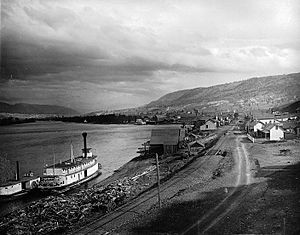
The first European explorers arrived in 1811. David Stuart, a fur trader, spent a winter with the Secwépemc people. In May 1812, another trader named Alexander Ross set up a trading post called "Fort Cumcloups."
Another company, the North West Company, built Fort Shuswap nearby that same year. The two companies later joined together in 1813. In 1821, the Hudson's Bay Company took over, and the post became known as Thompson's River Post, or Fort Thompson. Later, it was called Fort Kamloops.
After the forts were built, Kwa'lila, the chief of the local Secwépemc village, moved his people closer to the trading post. This helped them control who could access the post. After Kwa'lila, his nephew Nicola became chief. He led an alliance of Syilx (Okanagan) and Nlaka'pamux peoples.
Chief Nicola and the fur traders sometimes had disagreements. However, Chief Nicola helped settlers during the Fraser Canyon Gold Rush in 1858. Kamloops was an important stop on the Hudson's Bay Brigade Trail. This trail connected Fort Vancouver with other forts to the north. It was also key during the Cariboo Gold Rush as a main route to the new goldfields.
The 1862 Pacific Northwest smallpox epidemic spread through the Kamloops area in 1862. It greatly affected the Secwepemc, Nlaka'pamux, and other Indigenous peoples. They had no protection against the disease. The epidemic started in Victoria and quickly spread. Many Indigenous people died. After the epidemic, settlers took over traditional lands.
The gold rush of the 1860s and the building of the Canadian Pacific Railway helped Kamloops grow. The railway reached Kamloops in 1885. The City of Kamloops officially became a city in 1893. Its population was about 500 people.
In 1967, Kamloops joined with the Town of North Kamloops. In 1973, Kamloops joined with more areas like Brocklehurst and Valleyview. The Kamloops Indian Band also joined for a short time, but then separated in 1976.
In May 2021, researchers found possible graves of 215 children at the site of the former Kamloops Indian Residential School. This school was part of the Canadian Indian residential school system. The discovery was made using ground-penetrating radar. This news was shared worldwide.
What Does "Kamloops" Mean?
The name "Kamloops" comes from the Shuswap word "Tk'əmlúps". This word means "meeting of the waters." The Shuswap language is still spoken by members of the Tk'emlúps Indian Band in the area.
Some people also say the name might come from the French words "Camp des loups", meaning "Camp of Wolves." Many early fur traders were French. There are old stories about wolves attacking a traders' camp.
Geography of Kamloops
Kamloops is located in the Thompson Valley. The city center is near where the north and south branches of the Thompson River meet. The city's neighborhoods spread out along these river branches. They also go up the steep hillsides.
The Kamloops Indian Band lands are just northeast of downtown. You have to pass through these lands to reach some northern communities like Rayleigh and Heffley Creek. Kamloops is surrounded by smaller communities like Cherry Creek and Savona.
Kamloops Neighbourhoods
Kamloops has many official neighborhoods. Some of these also have smaller, informal areas within them.
- Aberdeen
- Barnhartvale
- Batchelor Heights
- Brocklehurst
- Campbell Creek
- Dallas
- Downtown
- Dufferin
- Heffley Creek
- Juniper Ridge
- Knutsford
- Lower Sahali
- Mission Flats
- Noble Creek
- North Kamloops
- Pineview
- Rayleigh
- Rose Hill
- Sagebrush
- Southgate
- Thompson Rivers University (TRU)
- Tranquille
- Upper Sahali
- Valleyview
- West End
- Westsyde
Kamloops Climate
Kamloops has a semi-arid climate. This means it's quite dry. It's in a rain shadow, which means mountains block most of the rain. Sometimes, very cold Arctic air can cross the mountains, bringing short cold spells.
Kamloops has one of the mildest winters for a city not on the coast in Canada. The coldest months are December and January. Summers are long, hot, and sunny. Daytime air can be very dry, which helps the nights cool down a lot. Sometimes, summer thunderstorms can start forest fires, which are common in the area.
Kamloops is in a dry region similar to parts of Washington and Oregon in the US. This area has unique plants and animals. You can find ponderosa pine trees, big sagebrush, prickly pear cactus, rattlesnakes, and black widow spiders.
The hottest temperature ever recorded in Kamloops was 47.3 °C (117 °F) on June 29, 2021. This was one of the highest temperatures ever recorded in Canada. The coldest temperature ever was −38.3 °C (−37 °F) in January 1950.
| Climate data for Kamloops Airport, 1991–2020 normals, extremes 1890–present | |||||||||||||
|---|---|---|---|---|---|---|---|---|---|---|---|---|---|
| Month | Jan | Feb | Mar | Apr | May | Jun | Jul | Aug | Sep | Oct | Nov | Dec | Year |
| Record high humidex | 15.8 | 17.0 | 23.3 | 31.9 | 36.8 | 48.0 | 40.4 | 40.3 | 38.4 | 31.2 | 22.8 | 15.0 | 48.0 |
| Record high °C (°F) | 16.1 (61.0) |
17.8 (64.0) |
23.3 (73.9) |
33.3 (91.9) |
37.8 (100.0) |
47.3 (117.1) |
41.7 (107.1) |
40.8 (105.4) |
38.3 (100.9) |
31.3 (88.3) |
22.8 (73.0) |
16.1 (61.0) |
47.3 (117.1) |
| Mean daily maximum °C (°F) | 0.4 (32.7) |
3.9 (39.0) |
10.7 (51.3) |
16.5 (61.7) |
22.0 (71.6) |
25.1 (77.2) |
29.3 (84.7) |
28.8 (83.8) |
22.8 (73.0) |
13.6 (56.5) |
5.8 (42.4) |
1.0 (33.8) |
15.0 (59.0) |
| Daily mean °C (°F) | −2.7 (27.1) |
−0.2 (31.6) |
5.2 (41.4) |
9.9 (49.8) |
15.0 (59.0) |
18.4 (65.1) |
21.9 (71.4) |
21.3 (70.3) |
16.0 (60.8) |
8.6 (47.5) |
2.3 (36.1) |
−2.0 (28.4) |
9.5 (49.1) |
| Mean daily minimum °C (°F) | −5.7 (21.7) |
−4.3 (24.3) |
−0.5 (31.1) |
3.2 (37.8) |
8.1 (46.6) |
11.6 (52.9) |
14.5 (58.1) |
13.7 (56.7) |
9.2 (48.6) |
3.5 (38.3) |
−1.1 (30.0) |
−5.0 (23.0) |
3.9 (39.0) |
| Record low °C (°F) | −38.3 (−36.9) |
−32.8 (−27.0) |
−26.1 (−15.0) |
−10.6 (12.9) |
−5.6 (21.9) |
0.6 (33.1) |
3.3 (37.9) |
0.6 (33.1) |
−3.9 (25.0) |
−17.1 (1.2) |
−30.0 (−22.0) |
−36.1 (−33.0) |
−38.3 (−36.9) |
| Record low wind chill | −42.0 | −36.7 | −33.9 | −13.0 | −5.2 | 0.0 | 0.0 | 0.0 | −6.5 | −23.2 | −39.1 | −45.1 | −45.1 |
| Average precipitation mm (inches) | 21.1 (0.83) |
12.4 (0.49) |
12.8 (0.50) |
14.2 (0.56) |
27.3 (1.07) |
37.4 (1.47) |
31.4 (1.24) |
23.7 (0.93) |
29.4 (1.16) |
19.4 (0.76) |
23.3 (0.92) |
25.4 (1.00) |
277.6 (10.93) |
| Average rainfall mm (inches) | 5.3 (0.21) |
5.9 (0.23) |
9.7 (0.38) |
14.0 (0.55) |
27.3 (1.07) |
37.4 (1.47) |
31.4 (1.24) |
23.7 (0.93) |
29.4 (1.16) |
19.0 (0.75) |
14.2 (0.56) |
7.1 (0.28) |
224.3 (8.83) |
| Average snowfall cm (inches) | 18.7 (7.4) |
8.0 (3.1) |
3.5 (1.4) |
0.2 (0.1) |
0.0 (0.0) |
0.0 (0.0) |
0.0 (0.0) |
0.0 (0.0) |
0.0 (0.0) |
0.3 (0.1) |
10.9 (4.3) |
21.9 (8.6) |
63.5 (25.0) |
| Average precipitation days (≥ 0.2 mm) | 9.7 | 7.2 | 6.8 | 6.2 | 10.2 | 10.7 | 8.4 | 8.0 | 7.6 | 9.0 | 10.0 | 11.7 | 105.6 |
| Average rainy days (≥ 0.2 mm) | 3.6 | 3.8 | 5.5 | 6.1 | 10.2 | 10.7 | 8.3 | 8.0 | 7.6 | 8.8 | 7.1 | 3.4 | 83.3 |
| Average snowy days (≥ 0.2 cm) | 7.6 | 4.1 | 1.9 | 0.3 | 0.0 | 0.0 | 0.0 | 0.0 | 0.0 | 0.3 | 3.9 | 9.3 | 27.4 |
| Average relative humidity (%) | 72.6 | 60.0 | 43.0 | 35.6 | 36.2 | 36.4 | 33.5 | 34.4 | 41.4 | 52.9 | 65.9 | 70.9 | 48.6 |
| Mean monthly sunshine hours | 55.2 | 95.6 | 165.3 | 202.8 | 251.6 | 252.0 | 303.4 | 289.5 | 223.3 | 130.9 | 63.7 | 46.6 | 2,079.8 |
| Percent possible sunshine | 20.9 | 33.9 | 45.0 | 49.0 | 52.4 | 51.2 | 61.2 | 64.3 | 58.7 | 39.2 | 23.5 | 18.6 | 43.2 |
| Source: Environment Canada | |||||||||||||
| Hottest summer Max. | Most days above 30 °C (86 °F) | Driest | Warmest spring | Fewest fog days | Most sunny days in warm months | Most growing degree days | Most days without precipitation | ||||||
|---|---|---|---|---|---|---|---|---|---|---|---|---|---|
| Rank among 100 largest Canadian cities | 1st | 1st | 2nd (next to Whitehorse) |
2nd (next to Chilliwack) |
2nd (next to Penticton) |
2nd (next to Portage la Prairie) |
3rd (next to Windsor and St. Catharines) |
3rd (next to Medicine Hat and Lethbridge) |
|||||
| Value | 27.73 °C (81.9 °F) | 35.9 | 272.9 mm (10.74 in) | 10.03 °C (50.1 °F) | 7.28 | 148.93 | 2308.61 | 258.12 | |||||
| Data is for Kamloops Airport (YKA), in the city of Kamloops, 5 NM (9.3 km; 5.8 mi) west northwest of the town. | |||||||||||||
People of Kamloops
| Historical population | ||
|---|---|---|
| Year | Pop. | ±% |
| 1881 | 200 | — |
| 1891 | 1,500 | +650.0% |
| 1901 | 1,359 | −9.4% |
| 1911 | 3,772 | +177.6% |
| 1921 | 4,501 | +19.3% |
| 1931 | 6,167 | +37.0% |
| 1941 | 5,959 | −3.4% |
| 1951 | 8,099 | +35.9% |
| 1956 | 9,096 | +12.3% |
| 1961 | 10,076 | +10.8% |
| 1966 | 10,759 | +6.8% |
| 1971 | 26,168 | +143.2% |
| 1976 | 58,311 | +122.8% |
| 1981 | 64,048 | +9.8% |
| 1986 | 61,773 | −3.6% |
| 1991 | 67,057 | +8.6% |
| 1996 | 76,394 | +13.9% |
| 2001 | 77,281 | +1.2% |
| 2006 | 80,376 | +4.0% |
| 2011 | 85,678 | +6.6% |
| 2016 | 90,280 | +5.4% |
| 2021 | 97,902 | +8.4% |
| Sources: Statistics Canada | ||
In 2021, Kamloops had 97,902 people living in 39,914 homes. This was a 8.4% increase from 2016. The city's land area is about 297.93 km2 (115.03 sq mi).
Different Cultures in Kamloops
Kamloops is home to people from many different backgrounds.
Religion in the City of Kamloops (2021) Irreligious (60.5%) Christianity (33.6%) Sikhism (2.1%) Hinduism (1.1%) Islam (0.9%) Buddhism (0.5%) Indigenous Spirituality (0.2%) Judaism (0.1%) Other religion (0.9%)
Most people in Kamloops do not report a religion (60.5%). About 33.6% of people are Christian. Other religions include Sikh (2.1%), Hindu (1.1%), and Muslim (0.9%).
The city has a diverse mix of ethnic groups. In 2021, the largest group was European. There is also a significant Indigenous population. Other groups include South Asian, East Asian, and Southeast Asian people.
Chinese Canadians in Kamloops
Kamloops once had a Chinatown on Victoria Street. Many Chinese immigrants lived there, especially by 1890. They mostly worked on building the Canadian Pacific Railway.
Over time, many Chinese people moved away for work. Fires in 1892 and 1893 also affected the Chinatown. Peter Wing, who was the first mayor of Chinese descent in North America, was elected in Kamloops in 1966.
The Kamloops' Chinese Cemetery was founded in the 1880s. It is the only one in British Columbia just for Chinese pioneers. In 2013, the government talked about apologizing for past wrongs against Chinese people in B.C. Some suggested building a museum in Kamloops to honor Chinese history.
Kamloops Economy
Kamloops' economy relies on several key areas. These include healthcare, tourism, education, transportation, and natural resources.
The Royal Inland Hospital (RIH) is the biggest employer in the city. It is a major hospital for the region.
Thompson Rivers University (TRU) is a large school with many students. It also has a big online learning program called Thompson Rivers University, Open Learning (TRU-OL). This makes it one of the largest online education providers in Canada.
Major industries in the area include processing natural resources. Examples are the Domtar Kamloops Pulp Mill and the Highland Valley Copper Mine.
Kamloops is a transportation hub because four major highways meet here. These are the Trans-Canada Highway, the Coquihalla Highway, the Yellowhead Highway, and British Columbia Highway 97. Many trucking companies are based in Kamloops. Both the Canadian Pacific Railway and the Canadian National Railway also pass through the city.
Tourism in Kamloops
Tourism is a big part of Kamloops' economy. In 2017, about 1.8 million people visited the city. This brought in a lot of money for local businesses.
Kamloops has over 50 places to stay, from large hotels to bed and breakfasts. Tourism helps create jobs and supports local businesses. It also encourages protecting the natural beauty of the area.
Arts and Culture in Kamloops
Kamloops has a growing arts and culture scene. It celebrates local talent in food, sports, live shows, and fine art.
The city hosts many cultural events throughout the year:
- Kamloops Wine Festival: This event raises money for the Kamloops Art Gallery.
- Kamloops Film Festival: Since 1997, this festival shows international films for ten days in March.
- River Beaver Classic: A mountain biking festival in April that raises money for trail maintenance.
- Brewloops: A non-profit festival celebrating local beer, food, and bikes.
- Kamloops International Buskers Festival: This four-day festival features street performers from around the world in Riverside Park.
- Hot Nite in the City Show 'n' Shine: A weekend event in August showing off classic cars and other vehicles.
- Kamloops Rotary Ribfest: Western Canada's largest rib festival, held in August at Riverside Park.
- Salute to the Sockeye Festival: This festival celebrates the return of sockeye salmon to the Adams River each fall.
- Kamloops Comedy Fest: Canadian comedians perform for a weekend in October.
- Words Alive Kamloops: This event features Canadian authors reading their work and holding workshops.
Performing and Fine Arts
Kamloops has several art spaces. These include the Kamloops Art Gallery and the Secwepemc Museum and Heritage Park. The Kamloops Symphony Orchestra and Western Canada Theatre also call Kamloops home.
Downtown Kamloops has 29 outdoor murals, part of the "Back Alley Art Gallery." Many artists have contributed to this project.
Project X Theatre puts on an outdoor theatre festival in Prince Charles Park during the summer. The Western Canada Theatre is a professional theatre company. They perform in two venues: the Sagebrush Theatre and the Pavilion Theatre.
Attractions in Kamloops
Popular attractions include: the Adams River Sockeye Salmon Run, Kamloops Bike Ranch, BC Wildlife Park, Kamloops Heritage Railway, and the Kamloops Wine Trail. The Secwepemc Museum is also a popular spot.
Since 2012, four wineries have opened in the Thompson Valley. These are Sagewood Winery, Harper's Trail Winery, Monte Creek Ranch Winery, and Privato Vineyard and Winery. Several micro-breweries have also opened in Kamloops since 2010.
Food and Drink
"Chefs in the City" is an annual event celebrating local food, wine, and beer. It raises money for charity.
Kamloops is becoming known for its wines. The climate is great for growing grapes like Riesling, Chardonnay, and pinot gris. The Kamloops Wine Festival supports the Kamloops Art Gallery.
The Brewloops Beer Festival celebrates BC craft beer, music, and entertainment. It also donates money to community groups.
Recreation in Kamloops
Kamloops is a great place for outdoor activities. It has many trails for hiking and mountain biking all year. Nearby lakes are perfect for paddling, kayaking, and fishing.
Known as the Tournament Capital of Canada, Kamloops hosts many sports events. The city has the Kamloops Sports Hall of Fame.
Fishing in Kamloops
With 100 lakes nearby, Kamloops offers excellent freshwater fishing. Each year, many fish like rainbow trout and kokanee salmon are added to the lakes.
Mountain Biking in Kamloops
Kamloops has a huge network of trails for mountain biking. The dry climate allows for biking almost all year. Popular spots include the Kamloops Bike Ranch and Kenna Cartwright Park. Famous mountain bikers like Catharine Pendrel and Wade Simmons live and train here.
Golf in Kamloops
Kamloops has many golf courses, one of the highest numbers per person in Canada. Golfers can play for three seasons because of the warm, dry climate. Some courses were designed by famous golf architects.
Skiing in Kamloops
Sun Peaks Resort is a ski and snowboard hill close to Kamloops. Olympic skier Nancy Greene Raine is involved with Sun Peaks. The Overlander Ski Club offers cross-country ski trails at Stake Lake.
Kamloops also has lacrosse teams and junior ice hockey teams like the Kamloops Storm. The Kamloops Broncos play football, and the Kamloops Excel play soccer at Hillside Stadium.
Other Fun Activities
The Kamloops Rotary Skatepark at McArthur Island Park is one of Canada's largest skateboard parks. McArthur Island Park also has NorBrock Stadium and a curling club. Kamloops has 82 parks, including Kenna Cartwright Park, which is the largest city park in British Columbia.
Sports in Kamloops
Hockey in Kamloops
Kamloops is home to the Western Hockey League's Kamloops Blazers. They play at the Sandman Centre. Many famous hockey players like Mark Recchi and Jarome Iginna used to play for the Blazers. Some of them are now part-owners of the team.
In 2016, Kamloops hosted Hockey Day in Canada.
Baseball in Kamloops
The West Coast League's Kamloops NorthPaws baseball team plays at NorBrock Stadium in Kamloops.
Sports Tournaments in Kamloops
Kamloops has hosted many big sports events:
- The 1993 Canada Summer Games.
- Co-hosted the IIHF World Junior Championship in 2005-2006.
- The 2006 BC Summer Games and 2018 BC Winter Games.
- The U15 boys and girls Basketball National Championship in 2008.
- The World Masters Indoor Championships in 2010.
- The 2011 Western Canada Summer Games.
- The 2014 Tim Hortons Brier (Canadian Men's Curling Championships).
- The 2014 4 Nations Cup.
- The 2016 IIHF Women's World Championship.
Getting Around Kamloops
Transportation in Kamloops
Kamloops is a major transportation hub. It is located where the Coquihalla Highway, Yellowhead Highway, and Trans-Canada Highway all meet.
Both the Canadian Pacific (CPR) and Canadian National (CNR) railway lines connect Vancouver to Kamloops. The Kamloops North station is served by Via Rail's Canadian train. The Rocky Mountaineer and the Kamloops Heritage Railway also use the Kamloops station.
Kamloops has its own airport, Kamloops Airport (YKA). Airlines like Air Canada Express and WestJet Encore fly to Kamloops. You can fly to Vancouver and Calgary from here.
After Greyhound Canada stopped its bus service in 2018, other companies like Ebus and Rider Express started offering intercity bus services. These connect Kamloops to Vancouver, Edmonton, and Calgary.
Local bus service is provided by the Kamloops Transit System. It has 14 routes across the Kamloops area. In 2018, the city worked with the Tk'emlúps te Secwépemc to expand bus service to their land.
Education in Kamloops
Schools for All Ages
Public schools in Kamloops are managed by School District 73 Kamloops/Thompson.
There are also private schools like Kamloops Christian School and St. Ann's Academy. For French-speaking students, the Conseil scolaire francophone de la Colombie-Britannique runs école Collines-d’or.
Learning After High School
Thompson Rivers University offers many programs, from certificates to university degrees. It also has smaller campuses in other towns like Clearwater and Williams Lake.
The university's online learning division, Thompson Rivers University, Open Learning (TRU-OL), is one of the biggest in Canada. The Thompson Rivers University WolfPack are the sports teams that represent the university.
Other private colleges in Kamloops include Thompson Career College and Sprott Shaw College.
Media in Kamloops
The city used to have a daily newspaper called The Kamloops Daily News, which stopped publishing in 2014. Another free newspaper, Kamloops This Week, also stopped in 2023.
Famous People from Kamloops
Many notable people have come from or lived in Kamloops.
Historical Figures
- Edward Bellew: A brave soldier who received the Victoria Cross.
- Jim Chamberlin: An expert in aerodynamics who helped design the Canadian Avro Arrow and worked on NASA's space programs.
- Chief Nicola: An important Indigenous leader during the fur trade and gold rush times.
- Robert W. Service: A famous poet known for his poems about the Klondike Gold Rush. He worked in Kamloops for a short time.
Politicians
- Jack Davis: A politician who served in both the Canadian Parliament and the British Columbia government.
- Davie Fulton: A politician who was a member of the Canadian House of Commons.
- Phil Gaglardi: Also known as "Flying Phil," he was a former Provincial Minister of Highways and Mayor of Kamloops.
- Leonard Marchand: The first person of First Nations background to serve in the Canadian government.
- Peter Wing: North America's first elected mayor of Chinese descent.
Athletes
- Graham Agassiz: A professional freeride mountain biker.
- Murray Baron: A former National Hockey League (NHL) ice hockey player.
- Mitch Berger: A former National Football League (NFL) player.
- Corryn Brown: A Canadian curler who won the 2013 Canadian Junior Curling Championships.
- Joe Hicketts: A hockey player who won the 2015 World Junior Ice Hockey Championship.
- Ethan Katzberg: A track and field athlete, 2023 World Champion in Hammer Throw.
- Kelly Olynyk: A professional basketball player for the Toronto Raptors and the Canadian national team.
- Catharine Pendrel: A cross-country mountain biker, Olympic bronze medalist, and World Champion.
- Mark Recchi: A former NHL ice hockey player who won the Stanley Cup three times. He is also in the Hockey Hall of Fame.
- Nancy Greene Raine: An Olympic skier who won gold for Canada in 1968. She was named Canada's Athlete of the Century in 1999.
- Logan Stankoven: A promising hockey player for the Dallas Stars and captain of the Kamloops Blazers.
Arts, Culture, and Media
- Benjamin Ayres: An actor born in Kamloops.
- Boris Karloff: A famous actor who joined a theatre company in Kamloops in 1911.
- Michael Shanks: An actor who grew up in Kamloops.
Kamloops in Space
The city's name has even been given to a crater on Mars! This crater, called "Crater Kamloops," was officially named in 1991. It is about 65 km (40 mi) wide.
Sister Cities
Kamloops has sister city relationships with:
- Uji, Kyoto Prefecture, Japan
- Bacolod, Negros Occidental, Philippines
Images for kids
-
Kamloops in the Fraser River watershed
See also
 In Spanish: Kamloops para niños
In Spanish: Kamloops para niños



